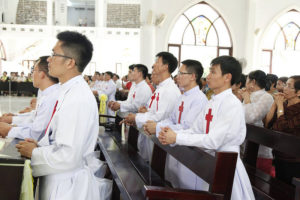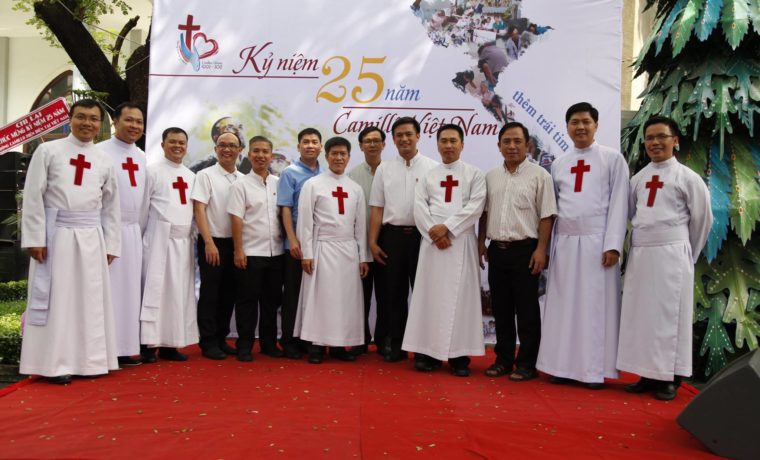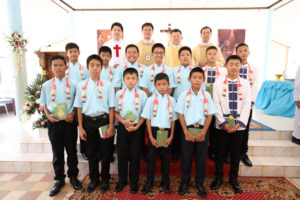Historical Notes
On 9 December 2017 the Camillian religious of Vietnam celebrated their twenty-fifth anniversary. This Camillian little plant had its first seed in an initiative of the Camillian religious Fr. Antonio Didonè who was at that time the Vice-Provincial Superior of Taiwan. He decided to visit this land and to establish contact with the parish priest of a Catholic church in the heart of Ho Chi Minh City (formerly Saigon).
The positive welcome that he received became a viaticum for a second visit by Fr. Didonè, who was joined by Fr. Felice Chech, with a view to establishing a concrete project for a presence of the Camillians in Vietnam. However, the geographical distance from Taiwan suggested that the most practicable way by which to implement this project would be to entrust it directly to the Camillian religious of Thailand, the next-door neighbour of Vietnam.
The then Provincial Superior of Thailand, Fr. Sante Tocchetto, took the situation in hand and with the agreement of the Superior General and the Provincial Council of Thailand proceeded to purchase a house (this was in the year 1993) which became the first home of our religious. This was a project financed by the Province of Austria.
The first young men selected to be Camillian candidates were at the outset received and accompanied by the Salesians.
In 1995 the Delegation of Thailand decided to send Fr. Armando Te Nuzzo to Vietnam to learn the local language and to accompany the candidates who were receiving formation, with the help and the cooperation of Fr. Peter Kahn, who would later be appointed a bishop, and of Fr. John Minh, who at that time was a priest of Notre Dame Cathedral in Ho Chi Minh City.
In the year 2003 the first professed Camillian religious, John Toai and Peter Vu Ngoc, after completing their theological studies in the Philippines, made their perpetual professions and returned to Vietnam.
Witnesses to the Camillian Charism
In 2004 the Archbishop of Ho Chi Minh City invited the Camillians to work with the archdiocese in caring for HIV/AIDS patients. The next year there was a further broadening of their ministry with the opening of a clinic where human, medical and pharmacological support was offered to about fifty poor people with HIV/AIDS. A short time afterwards the Mai Tam House of Hope was opened for the provision of care and support to orphan or abandoned children with HIV/AIDS (about 80 children between the age of 2 and 18). These children, in addition to the emotional problems connected to their condition, often had to deal with prejudice and rejection by other children or parents in their schools.
The witness that was offered, and the commitment demonstrated in living the Camillian charism, led the Archbishop officially to approve the presence of the Camillians in his diocesan church in 2007. It was during this period that the Nazareth House Hospice was inaugurated for abandoned dying people. This place, which is extremely poor and Spartan, has sixteen beds and seeks to humanise and give dignity to the sunset of life. In addition, the Dong Tien Clinic was opened to offer health-care services (physiotherapy, acupuncture, dental treatment and so forth) to poor people in need of care.
Following the steps that had been taken, the first Camillian community was erected canonically in 2009 at the Parish of the Immaculate Heart of Mary (Mau Tam) thanks to the generous cooperation of the parish priest who offered the Camillians the buildings adjacent to the parish.
In 2003 the Gary Home was founded for children with cancer from the Province. These children, together with their parents (involving a total of about 20-30 people), are accommodated and fed free of charge by the community while cancer treatment is being provided to them in the hospital.
A characteristic element of all these projects is that they are based, totally or in large measure, on the free part-time work of professionals (medical doctors, physiotherapists, nurses…), volunteers of the community, and patients who, after being helped, decide to remain connected to the Camillians in order to give to other people what they themselves have received.
The Protagonists of this Spring
 At the present time in Vietnam there are three canonically erected communities and in two of these there reside a growing number of students. At the moment there are 25 Vietnamese religious with perpetual vows, of whom 13 are priests, 17 religious with temporary vows; and 5 novices, who are currently in Thailand.
At the present time in Vietnam there are three canonically erected communities and in two of these there reside a growing number of students. At the moment there are 25 Vietnamese religious with perpetual vows, of whom 13 are priests, 17 religious with temporary vows; and 5 novices, who are currently in Thailand.
The presence of Vietnamese Camillians goes beyond the national boundaries because of cooperation projects with Thailand, where three religious are engaged in tasks involving formation (teachers of seminarians and teachers of novices), and another three religious in Taiwan who have parish and pastoral responsibilities. Two religious are in Europe: one is studying at the Gregorian University and the other is at the Centro de Humanizacion de la salud of Tres Cantos, Madrid (Spain).
An interesting characteristic of the group of Vietnamese religious is the fact that they entered religious life with a professional training behind them (physiotherapists, anaesthetists, nurses, social workers lawyers…).
Observations Following the Visit
This was my first visit to Vietnam and I had heard a number of my confreres speak well about what we are doing there. My brief stay there confirmed these very positive assessments of this little plant that is young but already flourishing and full of promise. Let us say that this mission constitutes a good drip-feed for the whole of the Order.
I was struck by the spirit of our religious and by the positive and joyous air that you can breathe in our houses. The communal style of life is simple and Spartan – there are no external employees and everyone is engaged in doing the cooking, the cleaning, the washing, the shopping for food, and so on, with the economic savings that this approach ensures.
Secondly, there is a strong social and Camillian feature to the priorities as regards care of the new mission. To employ the language of Pope Francis, one can affirm that our Vietnamese religious have privileged the ‘existential fringes’ by helping and giving dignity to the last, to the abandoned, to the poor and to the dying.
Thirdly, the spirit of St. Camillus of ‘more heart in those hands’ is supported by a spiritual framework that nurtures, inspires and conjoins ‘being with doing’: the face of ‘Martha and Mary’ in the exercise of the Camillian charism.
In addition, one can observe positive cooperation between the Camillian religious and the diocesan priests, in particular with those who offered the space of their parishes to host the community or the clinics, but also a constructive capacity for planning with the sisters of various religious Congregations.
For everything that has already occurred, gratitude is expressed; for everything that will occur, hope is expressed. The hope that the enthusiasm of the first group of Vietnamese Camillians will know how to address with wisdom, humility and tenacity the inevitable storms of existence; the hope that this little plant will grow more every day with the lymph of new candidates; and the hope that our religious will know how to discern and respond with creativity and farsightedness to new challenges, so as to bring the charism of St. Camillus and the spirit of the Good Samaritan to the variegated mosaic of the unfortunate people that they meet on the roads of Vietnam.
















Camillians on Facebook
Camillians on Twitter
Camillians on Instagram